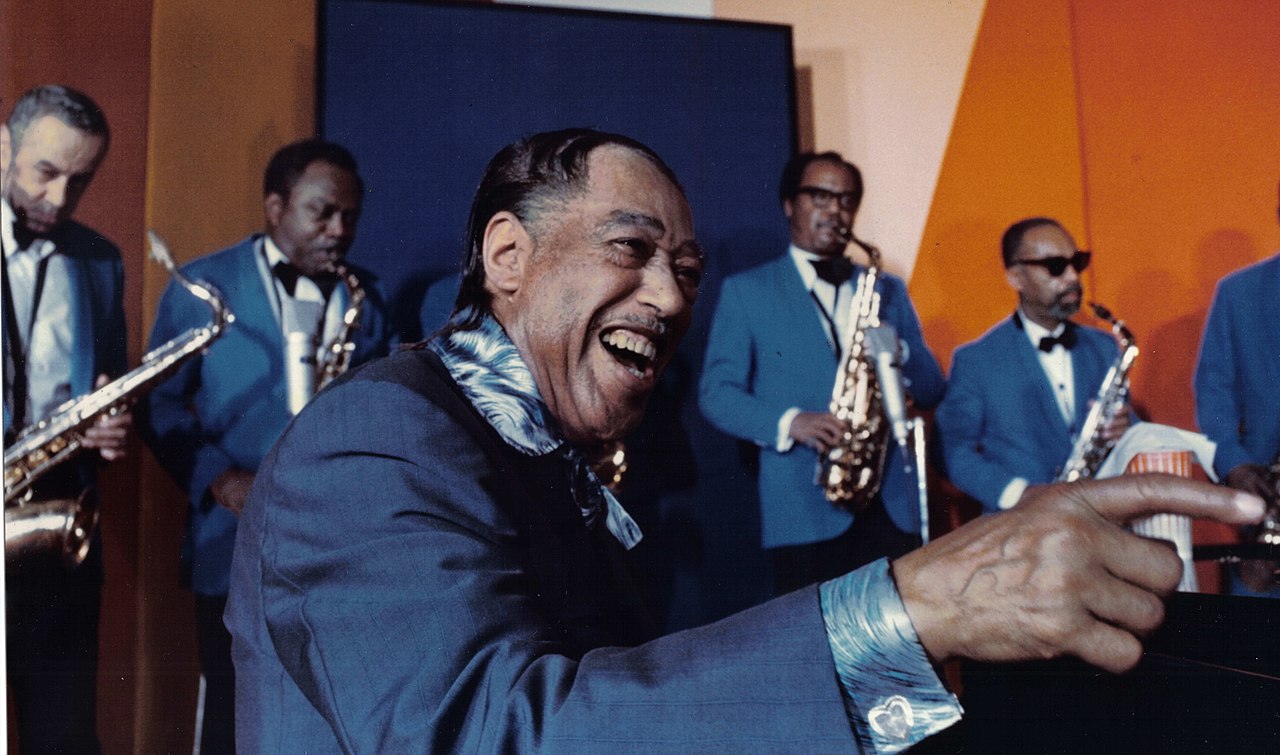
Duke Ellington, a commanding figure in music and cultural history, especially in the jazz world, died 50 years ago, on May 24, 1974.
Edward Kennedy Ellington was born into a lower middle-class family in Washington, D.C., on April 29, 1899. His mother was the daughter of a former slave. Both parents played the piano, so Ellington grew up in a musical household and began playing this instrument at the age of seven. Additionally, his parents instilled in their children the conviction that all people are equal, emphasizing that achievement and decency are the keys to progress and dignity. Ellington’s childhood was marked by pervasive racism, including the unrest of the “Red Summer” of 1919, three months of bloody violence. As a Black man, Ellington also had to assert himself in a hostile and discriminatory industry. These early experiences of racism and discrimination naturally impacted his music.
The 1920s were a time of artistic and cultural flourishing for Black Americans, particularly in Harlem. This Harlem Renaissance emerged in an era of intense racist oppression and social inequality, as a response to the ongoing Jim Crow era and the Ku Klux Klan. The artists of the Harlem Renaissance addressed the issues facing the African-American community through their work and promoted awareness of the need for social and economic justice. The movement was an attempt to break through systemic racism and promote alternative forms of identity and solidarity.
In 1923, Duke Ellington founded an ensemble with his childhood friend, drummer Sonny Greer, which would later become the Duke Ellington Orchestra. Over the years, the ensemble grew into a full-fledged jazz orchestra, gaining high fame. Originally emerging as a form of African-American folk music (blues, work songs, and spirituals), the term “jazz” first appeared in the early years of the 20th century and was initially used in connection with music originating in the Southern United States. Thus, Ellington made a relatively new, specifically Black musical genre his form of expression.

The musicians who joined Ellington’s orchestra under his leadership included some of the most talented jazz artists of the time, including saxophonist Johnny Hodges, trumpeter Bubber Miley, and clarinetist Barney Bigard. They performed in Harlem clubs and later in the legendary Cotton Club, when it only allowed Black artists and staff, but no Black audience. Jazz was often orchestrated to evoke a jungle atmosphere, projecting this idea onto African-Americans as exotic savages or plantation dwellers. Ellington’s contribution to music during the Harlem Renaissance went far beyond mere “entertainment” and undermined these stereotypes. His ability to merge various musical influences and create a unique sound paved the way for future generations of jazz musicians and solidified his legacy as one of the most important figures in American music history, emphasizing the potential of this artistic expression to contribute to broader movements for social change and equality.
An early success was Black and Tan Fantasy (1927), which referred to the name of the clubs where a mixed audience of Black and White patrons was admitted. The content of this composition was socially critical: A Black dancer dances herself to death due to love and financial hardship. The music included elements of blues, jazz, sacred, and classical European music (Chopin’s Funeral March). This remarkable composition was a direct challenge to the derogatory stereotypes associated with the then-called ‘jungle music.’ Its syncopated rhythms, improvisations, and the use of brass instruments elevated this sound to a very sophisticated level.
Ellington’s class consciousness, particularly regarding the Black working class, was often subtly woven into his compositions. Compositions such as Harlem Air Shaft (1940) are excellent examples of his ability to depict life in urban Black communities. In that piece Ellington musically portrays the cramped living conditions and lively atmosphere of a Harlem apartment building. The title refers to the airshafts in Harlem apartment buildings, capturing the atmosphere of bustling streets, crowded tenements, and pulsating energy. Ellington uses music to paint a sound portrait of everyday life in this neighborhood, incorporating elements of swing, blues, and improvisation to evoke the landmarks and sounds of Harlem.
As the civil rights movement gained momentum in the 1950s and advocated for racial equality through direct action, such as mass protests, boycotts, and sit-ins, Ellington was sometimes criticized for his more restrained approach. While Ellington’s earlier stand primarily consisted of using a specifically Black genre and imbuing it with artistry and dignity, as well as organizing benefit concerts, his approach evolved over time. By 1961, Ellington had included non-segregation clauses in his contracts and refused to perform before segregated audiences.
In the 1960s and 1970s, Ellington acted as a ‘jazz ambassador’ on behalf of the U.S. Department of State. During those years, he also traveled to socialist countries, including a five-week tour of the USSR in 1971. He reports about this trip in his autobiography Music is My Mistress (1973):

“Here no one ever moves from his or her seat until the entire concert and all the encores have been played. That impresses me very much. The enthusiasm is such, and the demand for encores so insistent, that some concerts run over four hours. Yet no one complains—not the audience, not the stagehands, and not even the cats in the band! The Russians come to hear our music, and for no other reason. Some are satisfied, and some are surprised how much they are satisfied.
“They come prepared for our version of ‘Caravan,’ which has long been a favorite in Russia, but not, I think, for our extended composition Harlem. After we have gone through the regular program, and are into the encores, and they are thinking they have heard all the band’s stars, then I feature two of its new members, Johnny Coles on flügelhorn and Harold Minerve on alto saxophone, who never fail to excite them. I finish every performance by playing Billy Strayhorn’s ‘Lotus Blossom,’ and that also is always graciously received. It seems to leave the audience suspended in euphoria, or beyond.”
Black, Brown, and Beige
During the 1930s, the idea of a large-scale composition about the experience of racism in the United States emerged. The premiere of Black, Brown, and Beige: A Tone Parallel to the History of the American Negro took place in 1943 at Carnegie Hall as part of a benefit event for Russian War Relief. The three-movement composition addressed three specific epochs of Africans after their enslavement in North America: slavery, their involvement in wars, and the contemporary period, with a focus on “Harlem and all the little Harlems in the U.S.” Ellington provided explanations for each movement, referring indirectly to the ongoing oppression. As Ellington writes in Music is My Mistress, the first section, “Black,” addresses the connection between work songs and spirituals. A devout person, Ellington made this connection between sacred music and field music, with spirituals referring to a church that slaves had no access to.
“Black” begins with dramatic drums, suggesting the African roots of the slaves. Through alternating motifs, saxophone solos, and innovative instrumentation, Ellington gives voice to the workers of the past. The second half, “Come Sunday,” describes the movement inside and outside the church, with a shift from melancholy to exuberant joy.
In the second section, “Brown,” Ellington honors the contribution of Blacks in various liberation wars. The first of three dances, the “West Indian Dance,” celebrates the heroic deeds of the seven hundred free Haitians who came to the aid of the Americans during the Siege of Savannah (1779). It then moves on to the Civil War and finally to a lighter mood in “Emancipation Celebration,” referring to the Emancipation Proclamation issued by Abraham Lincoln on January 1, 1863, during the American Civil War, which declared that all slaves in Confederate-controlled territory should be freed. The horns play a clave-like rhythm representing the West Indian influences in American music. Ellington creates a driving rhythmic ground for the saxophones, reminiscent of a train. A trumpet and trombone duet represents the hopeful mood of young people after emancipation, while lonely saxophones capture the melancholy of older generations uncertain of their future.
Thirdly, it deals with the Spanish-American War, with the return of decorated heroes who continued to be denied basic rights. This section naturally resonated with the contemporary audience regarding World War II. The “Double V” campaign expressed African-American hopes that the Black soldiers’ fight against fascism would mean an end to discrimination in their own country.

The final “Beige” movement criticizes contemporary racism. As Ellington writes, the movement expresses a new dignity for African Americans. It begins with lively music that reflects a certain stereotypical view of Blacks and is interrupted by a waltz that shows that there were “more churches than cabarets” in Harlem and that Blacks were educated and cultivated.
Each movement of Black, Brown, and Beige uses Ellington’s jazz idiom in characteristic ways to depict the harsh lives of Blacks who contributed significantly to building American society.
Works such as “Jump for Joy,” “Deep South Suite,” and “Beggar’s Holiday” are further examples of Ellington’s political engagement and efforts for social change through art. “Jump for Joy” was a Broadway-like show that spoke out against racism and advocated for an end to discrimination in the United States. “Deep South Suite” and “Beggar’s Holiday” addressed the discrimination and suffering of African Americans, particularly in the Southern states. Ellington’s music denounced social injustices and sought to bring about change even before the civil rights movement gained momentum.
His commitment to liberation was primarily evident in his music. Through his diverse musical repertoire, he demanded the same level of recognition and respect that was accorded to white composers. Ellington’s influence is immeasurable, not only on American music and culture but also on the global stage. He undoubtedly ranks among the great musicians of the twentieth century.
We hope you appreciated this article. At People’s World, we believe news and information should be free and accessible to all, but we need your help. Our journalism is free of corporate influence and paywalls because we are totally reader-supported. Only you, our readers and supporters, make this possible. If you enjoy reading People’s World and the stories we bring you, please support our work by donating or becoming a monthly sustainer today. Thank you!












Comments